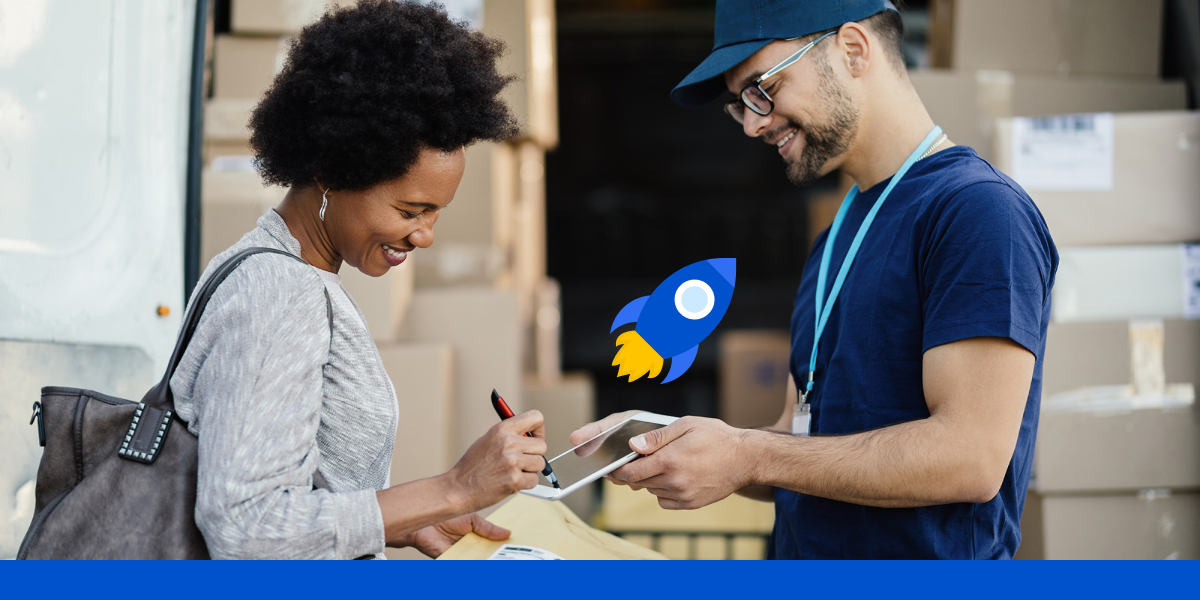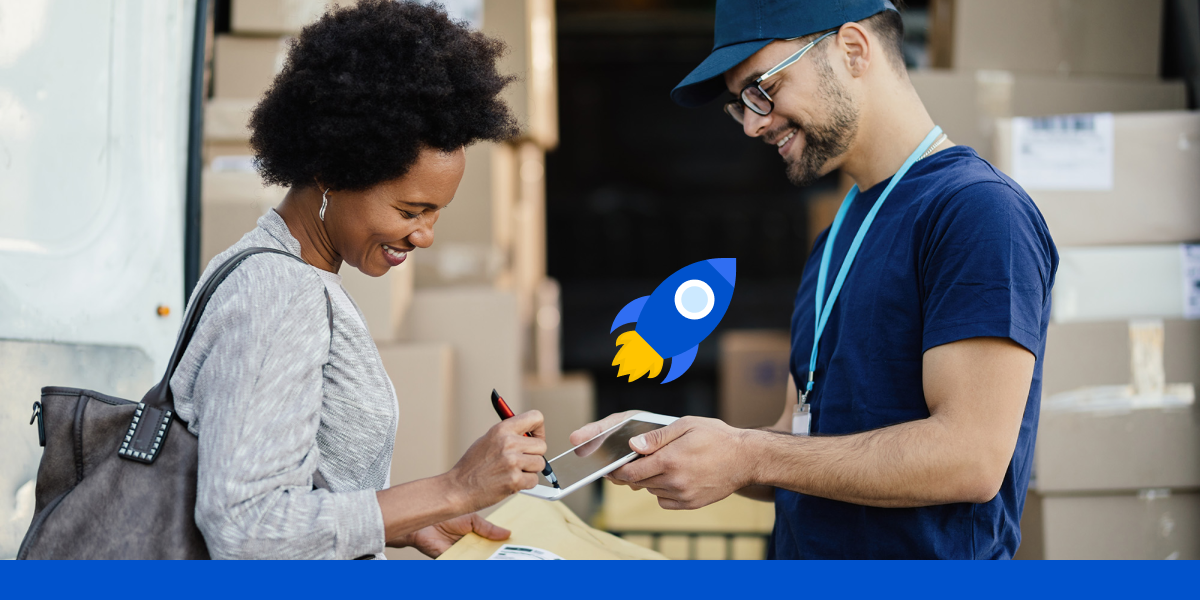If you could optimize just one of the many cascading steps that go into getting a package from online order to doorstep and save 90% of the time spent on customer inquiries, why wouldn’t you?

When optimizing delivery operations, few things pack as much punch as a proof of delivery system. It seems simple but, coming at the end of a long chain of events, it’s too often an afterthought.
In addition to saving labor on WISMO (where is my order) calls, proof of delivery can help operators pro-actively address mis-deliveries and damaged goods while also preventing false liability claims. One furniture retailer even cycles POD photos back to its designers so they can suggest additional products to customers based on their decor.
Understanding the Proof of Delivery Definition in Today’s Landscape
To appreciate why proof of delivery matters so much, let’s start with a clear proof of delivery definition: It’s the evidence—signatures, notes, timestamps, photos— that confirms a delivery has been completed successfully. This is the cornerstone of your delivery audit trail, providing irrefutable evidence of what was delivered, when, where, to whom, and in what condition.
In the past, proof of delivery relied on signatures on a paper slip that were manually input into accounting systems afterwards. While better than nothing, it left significant gaps in documentation quality and reliability. The handwritten signatures provided minimal context about the actual delivery conditions, timing, or any issues that might have occurred.
Advanced logistics management systems now capture photos, videos, digital signatures, GPS coordinates, and timestamps in real-time. Because it’s digital, the information can flow upstream into your ERP and downstream to accounting with no manual input required. This gives you the documentation to resolve customer questions quickly, process payments efficiently, and protect your business from unfounded claims.
The transformation from paper-based to digital proof of delivery isn’t just about convenience; it’s about creating a complete operational framework that supports every aspect of your delivery business. From billing customers and compensating drivers to managing returns and handling exceptions, robust proof of delivery becomes the thread that weaves together all your post-delivery processes.
Best Practice #1: Mandate Photographs
The internet dictum “pictures or it didn’t happen” applies here, too. High-quality photos verify that orders were delivered complete and undamaged, while also documenting any issues that occurred during transit or delivery. When delivery attempts fail, photos can prove that your driver arrived at the correct location during the scheduled time window.
The challenge is in ensuring consistency across your delivery team. Drivers operate under tight schedules and intense pressure to maintain productivity. Without proper systems in place, documentation can slip through the cracks. This is where the best driver delivery apps are invaluable.
Look for delivery applications that allow you to make photo uploads mandatory before closing a delivery ticket. When drivers can’t mark jobs complete without photos, you eliminate the possibility of missed documentation.
Consider implementing different photo requirements based on delivery types. High-value items might require multiple angles, while standard deliveries might need just one confirmation shot. Damaged or refused deliveries should trigger additional documentation requirements to capture the full context of the situation.
Best Practice #2: Leverage Automatic Time and Location Stamps
Context is everything when it comes to proof of delivery documentation. While photos provide visual evidence, combining them with precise time and location data creates a comprehensive record. This information should be captured automatically without input from your delivery team.
GPS coordinates and timestamps provide definitive proof that your driver was at the correct location during the scheduled delivery window, which is critical when handling failed delivery disputes. Customers occasionally claim that delivery attempts were never made, and having precise location and timing data can quickly resolve these situations.
Beyond dispute resolution, timestamped and geotagged proof of delivery enables sophisticated operational analysis. You can track driver performance, identify delivery pattern trends, and optimize route efficiency by analyzing when and where deliveries are completed. This data becomes particularly valuable for identifying bottlenecks or areas where additional training might benefit your team.
Your logistics management platform should automatically capture delivery information and immediately upload it to the cloud. Managers can evaluate damaged goods and provide a solution before the customer calls it in. Afterwards, whether you’re responding to a customer inquiry three days or three months after delivery, having precise time and location data at your fingertips streamlines the process.
Best Practice #3: Implement Dynamic Information Capture
Not all deliveries are created equal, and your proof of delivery system should reflect this reality. While signatures and photos provide valuable baseline documentation, certain delivery types require additional specific information to create a complete record. The key is implementing systems that can adapt to different delivery requirements without overwhelming your drivers with unnecessary work.
For example, when your team installs a dishwasher, documenting whether an existing air gap was present or whether your technicians left one could prove crucial if the customer experiences issues later. Similarly, construction site deliveries might require confirmation that pallets were properly stored and handled.
Your delivery app should let you create customized forms that appear automatically based on specific SKUs, order types, or delivery locations. Advanced systems allow for configurable logic that presents different follow-up questions depending on initial driver responses. This intelligent approach ensures you gather the exact information needed for each unique delivery situation.
Best Practice #4: Prioritize Seamless Integration Across All Delivery Channels
Capturing proof of delivery is only half the battle: the real value comes when this information integrates seamlessly with your business operations. Documentation should be instantly accessible across your organization, from customer service representatives handling inquiries to accounting teams processing payments.
Immediate upload and integration capabilities ensure that proof of delivery information becomes available in your logistics management dashboard the moment drivers complete their tasks. This real-time visibility enables proactive customer service, allowing you to identify and address potential issues before customers even realize problems exist. When deliveries are flagged with exceptions, having instant access to comprehensive documentation enables fast resolution and helps maintain customer satisfaction.
Integration is critical when working with third-party logistics providers or contract carriers. Your delivery partners represent your brand to customers, making it essential that you maintain the same level of visibility and documentation standards regardless of who actually handles the delivery. Robust integration capabilities allow you to extend your proof of delivery requirements to external partners, ensuring consistent service quality across your entire fulfillment network.
Look for solutions that make third-party integration straightforward rather than burdensome. The right platform will give you complete visibility into external deliveries without complex technical implementations or ongoing maintenance headaches.
Best Practice #5: Enhance Customer Experience Through Delivery Receipts
Proof of delivery documentation shouldn’t exist solely for your internal benefit—it can also serve as a powerful customer experience enhancement tool. Including photographic proof of delivery in customer receipts provides immediate value to recipients while reducing the volume of inquiries your customer service team needs to handle.
When customers receive detailed delivery receipts that include photos, timestamps, and location information, they have complete clarity about what was delivered and when. This transparency is valuable for business customers who need to process payments or manage inventory after a delivery is made. Rather than contacting your team for delivery confirmation, they have all necessary information readily available.
Automated delivery receipt generation should be a standard feature in your last mile delivery system. The right platform will let you customize receipt templates, ensuring that proof of delivery information is presented in a professional, branded format that reinforces your company’s commitment to transparency and excellence. When customers consistently receive comprehensive delivery documentation, they develop greater confidence in your reliability. This trust translates into increased customer retention, positive word-of-mouth referrals, and reduced time spent managing delivery-related inquiries.
Transforming Proof of Delivery into Competitive Advantage
Implementing these five best practices transforms proof of delivery from a basic operational requirement into a strategic competitive advantage. The right combination of mandatory documentation, automatic data capture, dynamic information gathering, seamless integration, and customer-focused communication creates a delivery experience that stands out in today’s crowded marketplace.
Success requires selecting technology solutions that support all these capabilities within a unified platform. Your driver delivery app should work seamlessly with your logistics management system to create comprehensive proof of delivery that enhances every aspect of your last mile delivery operations.
What happens after the package arrives is just as important as getting it there in the first place. By perfecting your proof of delivery processes, you create the foundation for operational excellence, customer satisfaction, and sustainable business growth.
{{cta(‘188233318763′,’justifycenter’)}}
